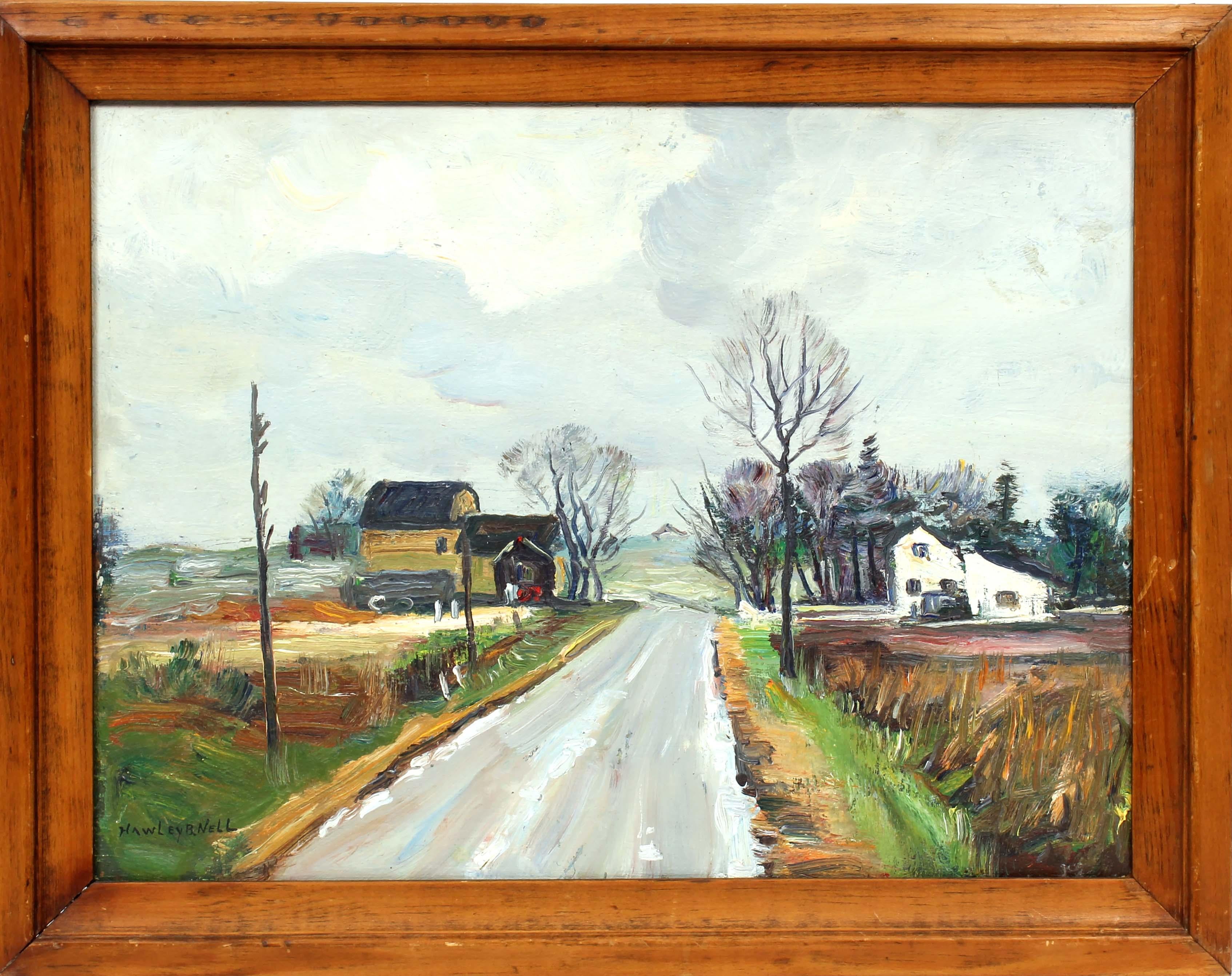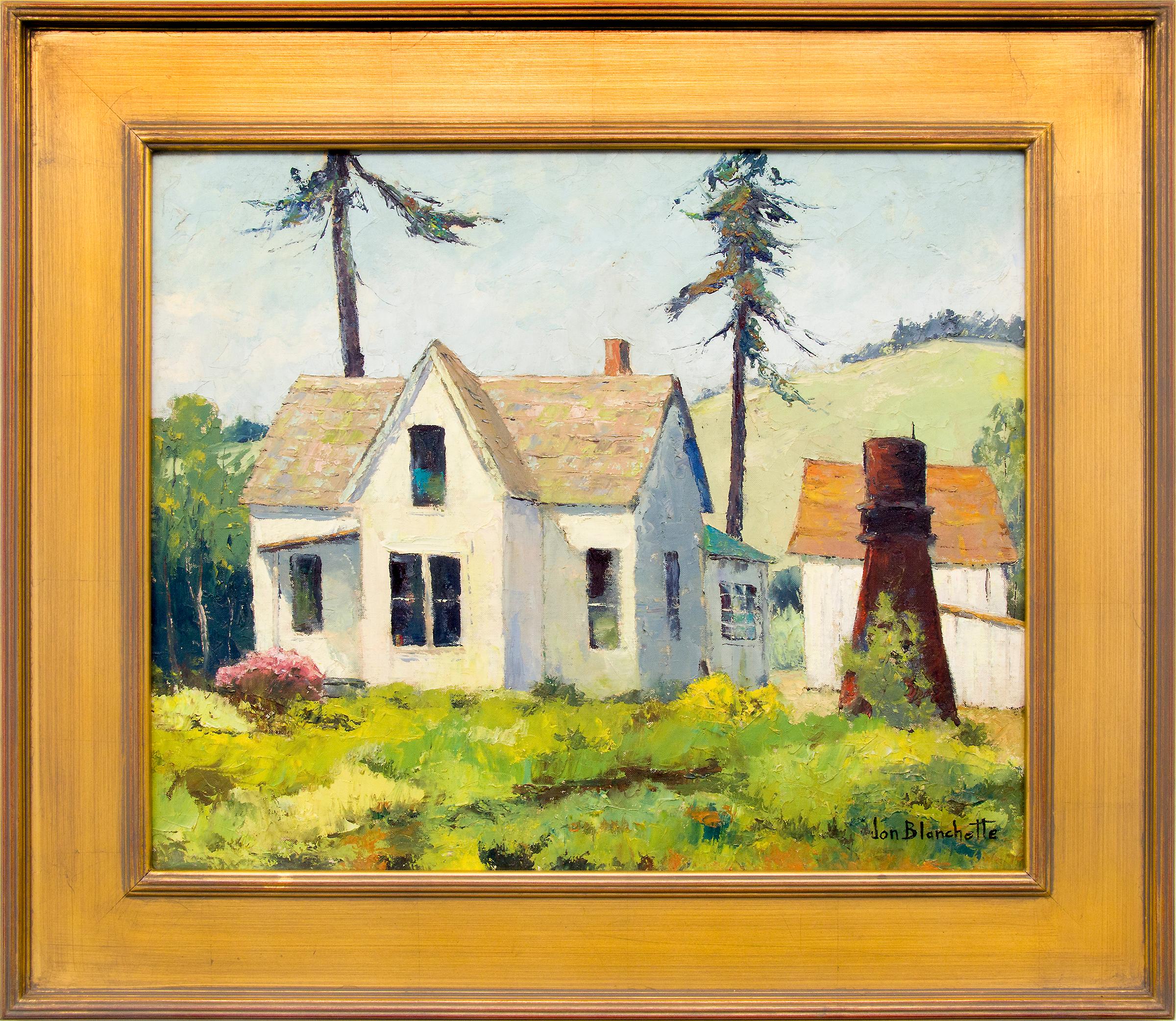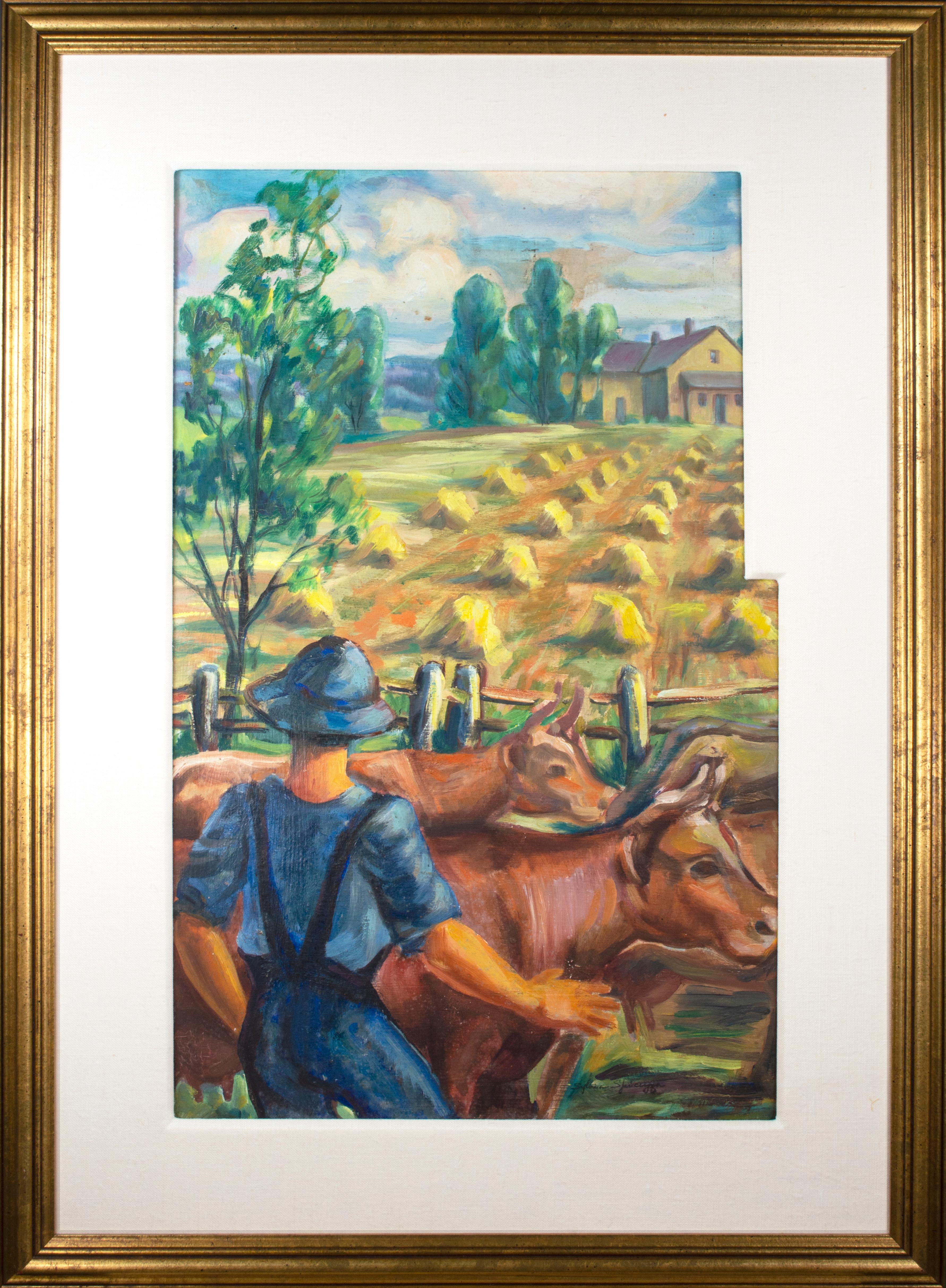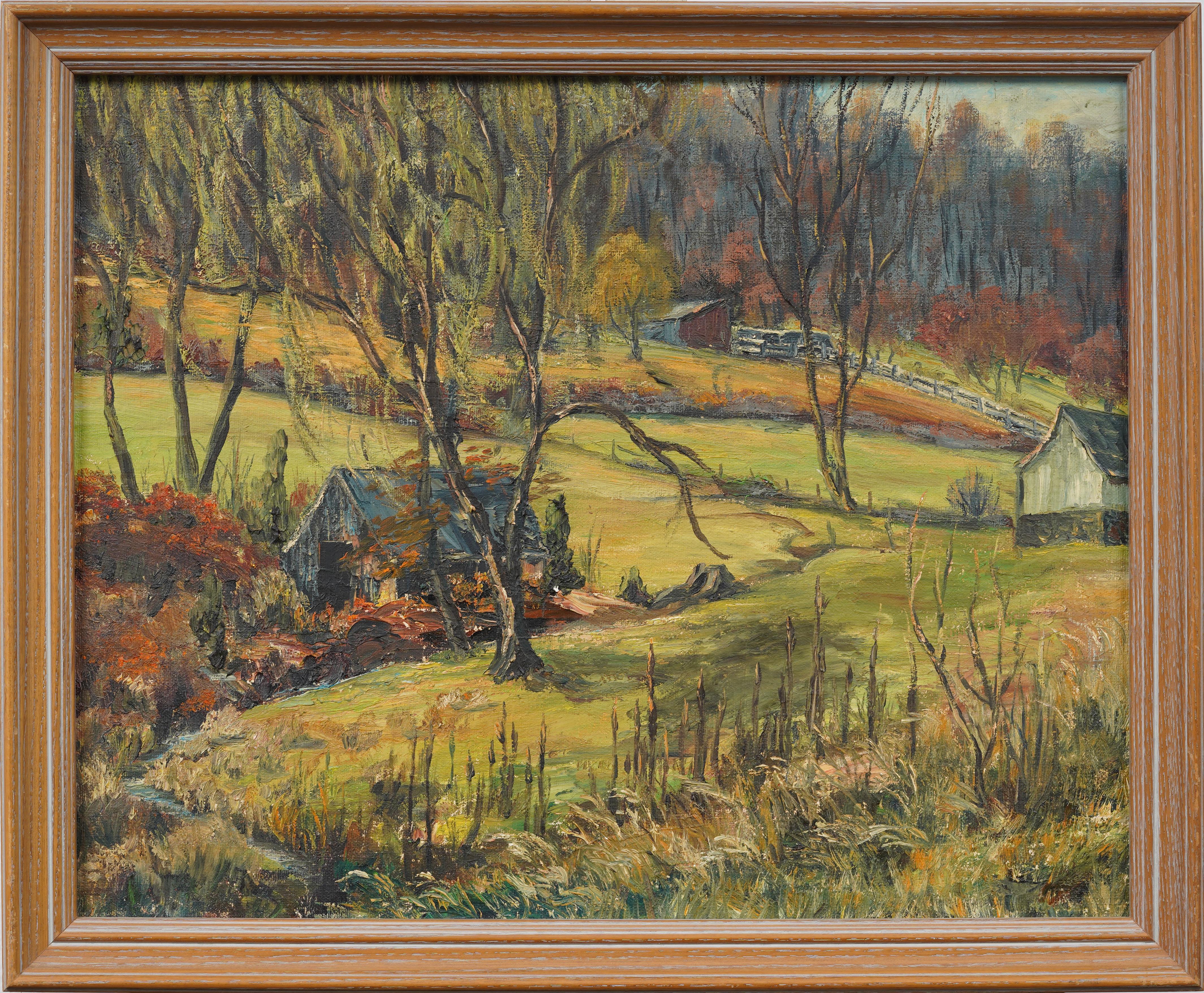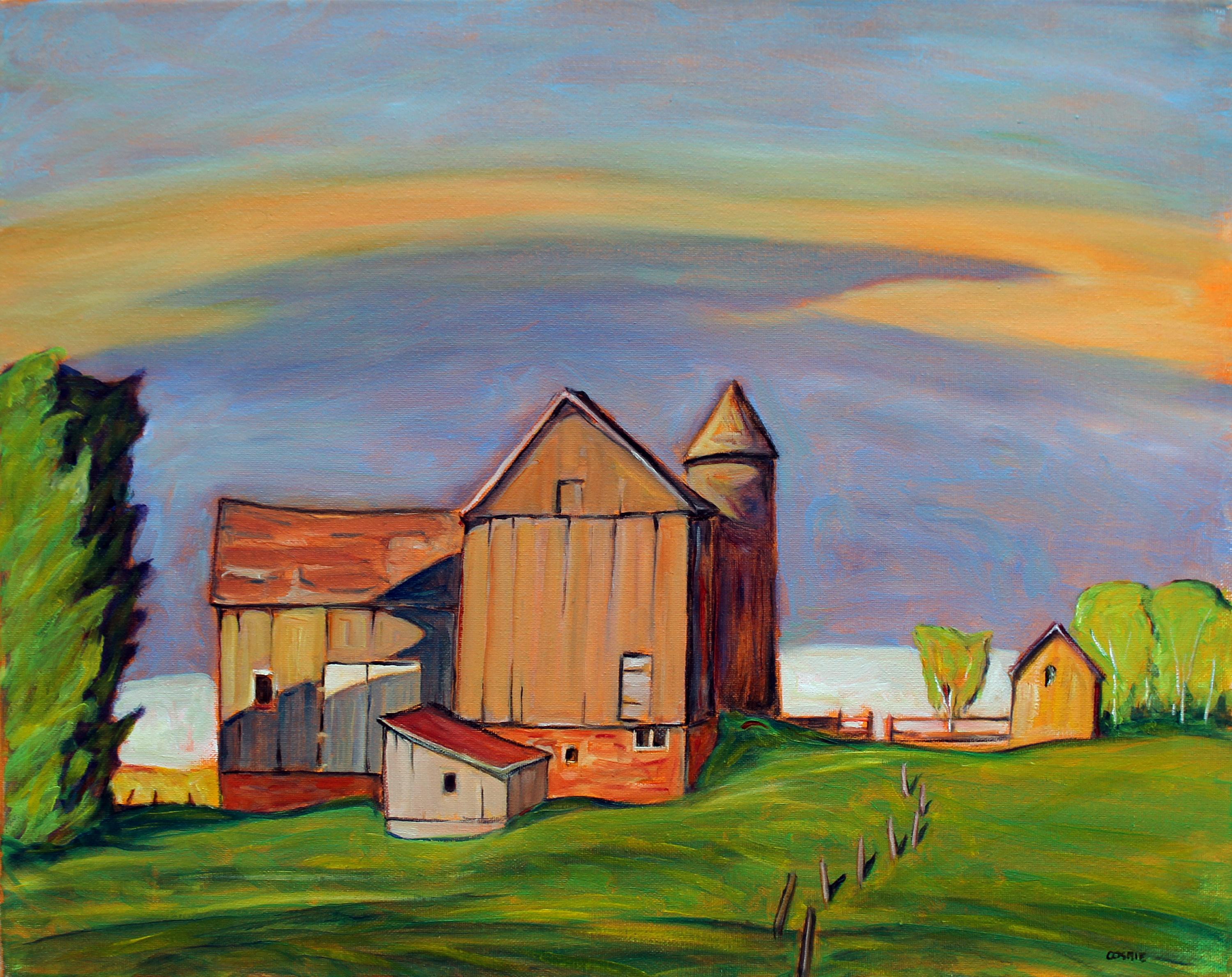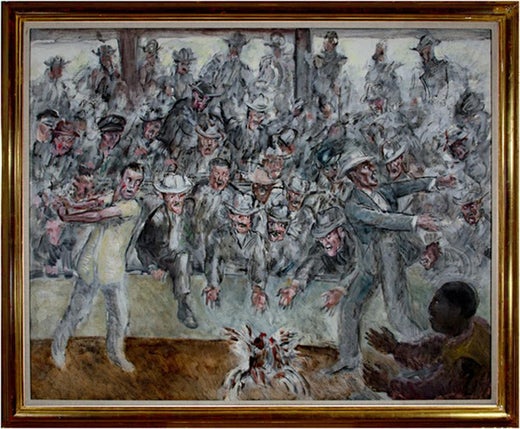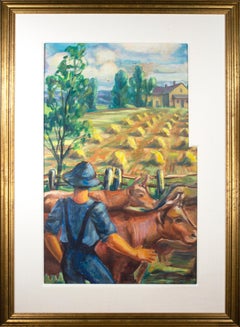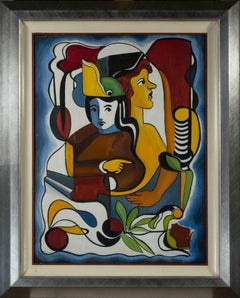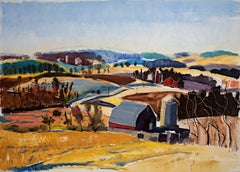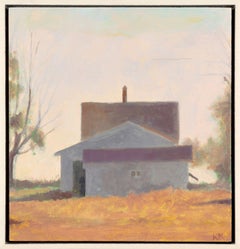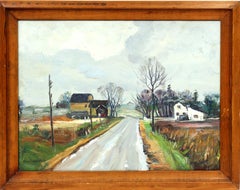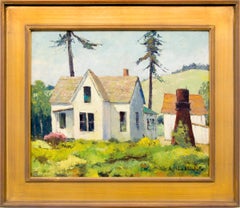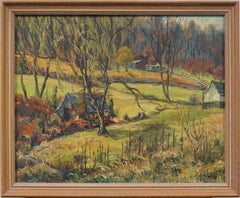Items Similar to 'Sketching Wisconsin' original oil painting, Signed
Want more images or videos?
Request additional images or videos from the seller
1 of 11
John Steuart Curry'Sketching Wisconsin' original oil painting, Signed1946
1946
$652,500
£496,604.79
€568,749.08
CA$928,076.20
A$1,017,038.93
CHF 531,118.88
MX$12,222,027.09
NOK 6,639,909.49
SEK 6,262,492.73
DKK 4,245,077.57
About the Item
John Steuart Curry
"Sketching Wisconsin," 1946
oil on canvas
31.13 x 28 inches, canvas
39.75 x 36.75 x 2.5 inches, frame
Signed and dated lower right
Overall excellent condition
Presented in a 24-karat gold leaf hand-carved wood frame
John Steuart Curry (1897-1946) was an American regionalist painter active during the Great Depression and into World War II. He was born in Kansas on his family’s farm but went on to study art in Chicago, Paris and New York as young man. In Paris, he was exposed to the work of masters such as Peter Paul Rubens, Eugène Delacroix and Jacques-Louis David. As he matured, his work showed the influence of these masters, especially in his compositional decisions. Like the two other Midwestern regionalist artists that are most often grouped with him, Grant Wood (American, 1891-1942) and Thomas Hart Benton (American, 1889-1975), Curry was interested in representational works containing distinctly American subject matter. This was contrary to the popular art at the time, which was moving closer and closer to abstraction and individual expression.
Sketching Wisconsin is an oil painting completed in 1946, the last year of John Steuart Curry’s life, during which time he was the artist-in-residence at the University of Wisconsin in Madison. The painting is significant in Curry’s body of work both as a very revealing self-portrait, and as a landscape that clearly and sensitively depicts the scenery of southern Wisconsin near Madison. It is also a portrait of the artist’s second wife, Kathleen Gould Curry, and is unique in that it contains a ‘picture within a picture,’ a compositional element that many early painting masters used to draw the eye of the viewer. This particular artwork adds a new twist to this theme: Curry’s wife is creating essentially the same painting the viewer is looking at when viewing Sketching Wisconsin.
The triangular composition of the figures in the foreground immediately brings focus to a younger Curry, whose head penetrates the horizon line and whose gaze looks out towards the viewer. The eye then moves down to Mrs. Curry, who, seated on a folding stool and with her hand raised to paint the canvas on the easel before her, anchors the triangular composition. The shape is repeated in the legs of the stool and the easel. Behind the two figures, stripes of furrowed fields fall away gently down the hillside to a farmstead and small lake below. Beyond the lake, patches of field and forest rise and fall into the distance, and eventually give way to blue hills.
Here, Curry has subverted the traditional artist’s self-portrait by portraying himself as a farmer first and an artist second. He rejects what he sees as an elitist art world of the East Coast and Europe. In this self-portrait he depicts himself without any pretense or the instruments of his profession and with a red tractor standing in the field behind him as if he was taking a break from the field work. Here, Curry’s wife symbolizes John Steuart Curry’s identity as an artist. Compared with a self-portrait of the artist completed a decade earlier, this work shows a marked departure from how the artist previously presented and viewed himself. In the earlier portrait, Curry depicted himself in the studio with brushes in hand, and with some of his more recognizable and successful canvases behind him. But in Sketching Wisconsin, Curry has taken himself out of the studio and into the field, indicating a shift in the artist’s self-conception.
Sketching Wisconsin’s rural subject also expresses Curry’s populist ideals, that art could be relevant to anyone. This followed the broad educational objectives of UW’s artist-in-residence program. Curry was appointed to his position at the University of Wisconsin in 1937 and was the first person to hold any such position in the country, the purpose of which was to serve as an educational resource to the people of the state. He embraced his role at the University with zeal and not only opened the doors of his campus studio in the School of Agriculture to the community, but also spent a great deal of time traveling around the state of Wisconsin to visit rural artists who could benefit from his expertise. It was during his ten years in the program that Curry was able to put into practice his belief that art should be meaningful to the rural populace. However, during this time he also struggled with public criticism, as the dominant forces of the art market were moving away from representation. Perhaps it was Curry’s desire for public acceptance during the latter part of his career that caused him to portray himself as an Everyman in Sketching Wisconsin.
Beyond its importance as a portrait of the artist, Sketching Wisconsin is also a detailed and sensitive landscape that shows us Curry’s deep personal connection to his environment. The landscape here can be compared to Wisconsin Landscape of 1938-39 (the Metropolitan Museum of Art), which presents a similar tableau of rolling hills with a patchwork of fields. Like Wisconsin Landscape, this is an incredibly detailed and expressive depiction of a place close to the artist’s heart. This expressive landscape is certainly the result of many hours spent sketching people, animals, weather conditions and topography of Wisconsin as Curry traveled around the state. The backdrop of undulating hills and the sweeping horizon, and the emotions evoked by it, are emphatically recognizable as the ‘driftless’ area of south-central Wisconsin. But while the Metropolitan’s Wisconsin Landscape conveys a sense of uncertainty or foreboding with its dramatic spring cloudscape and alternating bands of light and dark, Sketching Wisconsin has a warm and reflective mood. The colors of the foliage indicate that it is late summer and Curry seems to look out at the viewer approvingly, as if satisfied with the fertile ground surrounding him.
The landscape in Sketching Wisconsin is also revealing of what became one of Curry’s passions while artist-in-residence at UW’s School of Agriculture – soil conservation. When Curry was a child in Kansas, he saw his father almost lose his farm and its soil to the erosion of The Dust Bowl. Therefore, he was very enthusiastic about ideas from UW’s School of Agriculture on soil conservation methods being used on Wisconsin farms. In Sketching Wisconsin, we see evidence of crop rotation methods in the terraced stripes of fields leading down the hillside away from the Curry’s and in how they alternate between cultivated and fallow fields.
Overall, Sketching Wisconsin has a warm, reflective, and comfortably pastoral atmosphere, and the perceived shift in Curry’s self-image that is evident in the portrait is a positive one. After his rise to favor in the art world in the 1930’s, and then rejection from it due to the strong beliefs presented in his art, Curry is satisfied and proud to be farmer in this self-portrait. Curry suffered from high blood pressure and in his last years was especially crestfallen about criticism of his work in his home state of Kansas. The artist was only 48 when he died. In Sketching Wisconsin, it is almost as if Curry has decided to record the most important parts of his life with the knowledge that he did not have much time left. For that reason, this painting is perhaps more expressive and revealing of Curry’s life than any other from his last decade, if not his career.
This painting was exhibited at the Museum of Wisconsin Art, "John Steuart Curry: At Home in Wisconsin" in 2014
Essay by Monet C. Haskins and David J. Barnett
- Creator:John Steuart Curry (1897-1946, American)
- Creation Year:1946
- Dimensions:Height: 39.75 in (100.97 cm)Width: 36.75 in (93.35 cm)Depth: 2.5 in (6.35 cm)
- Medium:
- Movement & Style:
- Period:
- Framing:Frame IncludedFraming Options Available
- Condition:
- Gallery Location:Milwaukee, WI
- Reference Number:Seller: 12694g1stDibs: LU605312785442
John Steuart Curry
Born in Dunavant, Kansas on November 14, 1897, John Steuart Curry became the youngest member of the famed "Benton-Wood-Curry trio" of Regional Painters of the early 20th-century American Scene movement. He gained a national reputation for his rural Kansas scenes. The artist focused on people who were down-to-earth, plain spoken, and self-reliant, and who made a living through hard physical labor. Curry executed murals dealing with land settlement and racial justice, and his works reflecting these themes are in the Capitol Building in Kansas, the University of Wisconsin, the United States Department of the Interior, and the United States Department of Justice. The artist quit high school and attended the Kansas City Art Institute and School of Design. He transferred to the Art Institute of Chicago. Curry married Clara Derrick in 1923. He studied in Paris in 1927. He was not impressed by the modernist American painters, many of whom were adopting the 'isms' of French contemporary artists. Curry was determined to paint American subjects without European models and to celebrate patriotism, regional pride, and the common man. He settled in Westport, Connecticut. In 1928, he painted Baptism in Kansas. The painting was heralded nationally as work of a new American genre. It was exhibited at the Corcoran Gallery of Art biennial where it met critical acclaim. In 1931, Gertrude Vanderbilt Whitney bought it for her museum. Tornado over Kansas was unveiled in 1929 before the stock market crash and provided the city with the romance of man versus nature theme. In 1933, it received second prize at the Carnegie International Exhibit. In 1930, he had his first one-man exhibition at the Whitney Studio Club. His work of the 1930s contains themes of work, family, and land-- demonstrating the peace, struggle, and perseverance that Curry believed was the essence of American life. In 1934 he married Kathleen Shepard. The United States government selected him to paint murals for the Department of Justice and the Department of Interior. He was appointed Artist-in-Residence in the College of Agriculture at the University of Wisconsin in 1936. He was a member of the Art Students' League and won prizes including: Purchase prize, North West Print Maker, fifth annual Exhibition, 1933; second prize, Thirty-first International Exhibition, Carnegie Institute, 1933; gold medal, PAFA, 1941; prize, Artists for Victory Exhibition, the Metropolitan Museum of Art, 1941. Exhibitions include: “A Celebration of Rural America,” 2007, Danville Museum of Fine Arts and History; “Collective Images: the sketchbooks of John Steuart Curry, 2002, Worcester Art Museum; “Illusions of Eden: Visions of the American Heartland,” 2000, Columbus Museum of Art; “The American Century: Art and Culture 1900-2000,” Whitney Museum of American Art; and “John Steuart Curry: Inventing the Middle West,” 1998, M.H. de Young Memorial Museum. He died in Madison, Wisconsin in 1946.
About the Seller
4.9
Platinum Seller
Premium sellers with a 4.7+ rating and 24-hour response times
Established in 1966
1stDibs seller since 2017
450 sales on 1stDibs
Typical response time: 3 hours
- ShippingRetrieving quote...Shipping from: Milwaukee, WI
- Return Policy
Authenticity Guarantee
In the unlikely event there’s an issue with an item’s authenticity, contact us within 1 year for a full refund. DetailsMoney-Back Guarantee
If your item is not as described, is damaged in transit, or does not arrive, contact us within 7 days for a full refund. Details24-Hour Cancellation
You have a 24-hour grace period in which to reconsider your purchase, with no questions asked.Vetted Professional Sellers
Our world-class sellers must adhere to strict standards for service and quality, maintaining the integrity of our listings.Price-Match Guarantee
If you find that a seller listed the same item for a lower price elsewhere, we’ll match it.Trusted Global Delivery
Our best-in-class carrier network provides specialized shipping options worldwide, including custom delivery.More From This Seller
View All20th century figurative landscape oil painting pastoral scene farm field cow
By Sylvia Spicuzza
Located in Milwaukee, WI
This early work by American artist Sylvia Spicuzza is an excellent example of Regionalism: in the foreground, a farmer in blue stands before a herd of cattle. Beyond the fence of the...
Category
1930s American Modern Figurative Paintings
Materials
Oil, Board
"On Wisconsin, " Oil on Panel Portrait by Sylvia Spicuzza
By Sylvia Spicuzza
Located in Milwaukee, WI
"On Wisconsin" is an original oil painting on panel by Sylvia Spicuzza. The artist signed the piece in the lower left. This painting depicts two figures and other symbols to represen...
Category
1950s Figurative Paintings
Materials
Oil, Panel
"The Red Barn - Wisconsin Landscape Series, " Oil on Canvas signed by Dan Muller
By Dan Muller
Located in Milwaukee, WI
"The Red Barn - Wisconsin Landscape Series" is an original oil painting on canvas by Dan Muller. The artists signed the painting in the lower left....
Category
1990s Contemporary Landscape Paintings
Materials
Canvas, Oil
"Distant House" Oil Painting by Kevin Knopp in artist created frame
By Kevin Knopp
Located in Milwaukee, WI
"Distant House" is an original oil painting by the Wisconsin-based artist Kevin Knopp. Known for his lyrical landscapes and sensitive still life, influenced by what the artist calls,...
Category
21st Century and Contemporary Impressionist Landscape Paintings
Materials
Oil
Contemporary landscape oil painting colorful mountains forest sky signed
By Kevin Knopp
Located in Milwaukee, WI
'King's Bluff, La Crosse' is an original landscape in oil signed by the Midwestern artist Kevin Knopp. In the vista, mountains jutt out from either side of the canvas in deep greens ...
Category
2010s Contemporary Still-life Paintings
Materials
Linen, Oil
"Cabin on Lake Michigan Shore, " Oil on Board signed by Francesco Spicuzza
By Francesco Spicuzza
Located in Milwaukee, WI
"Cabin on Lake Michigan Shore" is an original oil painting on board by Francesco Spicuzza. The artist signed the piece in the lower left. It depicts a small cabin on the lakeshore surrounded by bright vegetation.
14" x 20" art
22 3/4" x 29" frame
Francesco J. Spicuzza, born in Sicily on July 23, 1883, came to America at the age of 8. He supported himself as a fruit peddler until a newspaperman gave him $4 a week to go to school. He attended classes at the Milwaukee Art Students League, where he studied under Alexander Mueller. There he learned to paint in the then-fashionable "Munich School" technique, with detailed realism in heavy browns and grayed-out hues. Spicuzza completed eight grades in four years, and then in 1911, three businessmen advanced him enough money to allow him to study in New York under artist and teacher John Carlson. It was during this time that Spicuzza changed his style of painting, developing an impressionistic use of color, form and atmospheric renditions. After a period of grinding poverty, one of Spicuzza's pictures won a major New York competition. It was the first of 60 wins, both in the U.S. and Paris. He became a fashionable painter, and many of the leading collections have his work. Spicuzza's typical works were beach scenes, still life, landscapes and portraits done in pastels, oils, ink, charcoal and watercolors. Much of his work traced the history of Milwaukee in the early 1900s. He was probably best known for his scenes of women and children splashing in the waves...
Category
1930s Landscape Paintings
Materials
Oil, Board
You May Also Like
Hawley Nell original American Antique Painting Impressionist Maine Gruppe framed
Located in Buffalo, NY
An original American impressionist oil painting of a country road in Maine by Emile Gruppe's cousin, American artist Haley B. Nell.
Not much else is known about Nell, although the a...
Category
Late 19th Century American Impressionist Landscape Paintings
Materials
Canvas, Oil
Jon Blanchette Northern California Countryside Oil Painting, Mid-Century
By Jon Blanchette
Located in Denver, CO
This charming Northern California landscape painting by American artist Jon Blanchette (1908–1987) captures the serene beauty of rural life in the mid-20th century. Painted circa 195...
Category
Mid-20th Century American Impressionist Landscape Paintings
Materials
Oil
Impressionistic Vermont Oil Painting by Louis DeDonato Salmagundi Label
Located in Chesterfield, NJ
Vermont Hills
oil/panel 8x10 unframed, 11.5 x 13.5 framed
Salmagundi Club Auction 2003 with auction label
I purchased this painting in 2003 at the Salmagundi Club Auction and have ow...
Category
2010s Landscape Paintings
Materials
Oil
Vintage American Impressionist Framed New England Farm Landscape Oil Painting
Located in Buffalo, NY
Oil on canvas, 18 x 22 inches overall, 16 x 20 inches image size.
Vintage American impressionist landscape painting. Oil on canvas. Framed.
Category
1950s Modern Landscape Paintings
Materials
Canvas, Oil
Evening, Lawrence County, Pennsylvania, Oil Painting
By Doug Cosbie
Located in San Francisco, CA
Artist Comments
At sunset, the landscape basks in the last ray of light. The gradual transition to the evening sky brings a golden color to the rural areas of Pennsylvania. F...
Category
21st Century and Contemporary Impressionist More Art
Materials
Oil
Coffee Time-American Scene Painting-Cranbrook Academy of Art-Michigan Travel
Located in Marco Island, FL
This is a delightful, large oil painting of a coffee run to a quintessential diner. Zolton Sepeshy, who lived and painted in Michigan, captured the stillness of the late-night or ea...
Category
Mid-20th Century American Realist Landscape Paintings
Materials
Canvas, Oil
